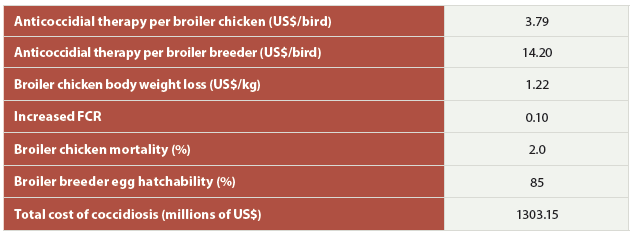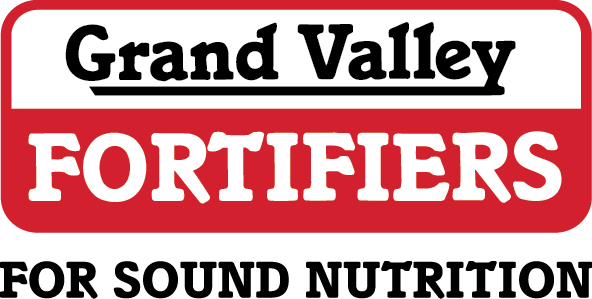By: Aline Pereira, M.Sc, DVM
Monogastric Nutritionist
Grand Valley Fortifiers
First, it is crucial to understand that coccidiosis in broilers, breeders, and layers is amplified by the intensive rearing conditions of modern barns, primarily due to the high density of birds (even in barns with a stocking density below 2.88 kg/ ft2). As coccidiosis is transmitted via the fecal-oral route, the greater the number of birds per square foot, the higher the likelihood of ingesting contaminated feces. In addition, the consumed amount of fecal material containing oocysts of Eimeria spp., the protozoan that causes the disease, determines the degree of challenge the birds will face. The intensive poultry system is the main reason why coccidiosis is so difficult to eradicate in commercial birds.
The consequences of coccidiosis are widely known and include reduced nutrient absorption, lower body weight gain, increased feed conversion, enteritis, and mortality in more severe cases. In addition, secondary effects such as increased litter moisture can result in undesirable conditions such as pododermatitis (inflammation of the skin of the foot), as well as requiring greater electricity consumption for ventilation to control this humidity. This scenario not only impacts the birds’ health and well-being, but also significantly burdens production.
From a nutritionist’s perspective, coccidiosis represents a major challenge, as the formulation of diets aim to optimize the use of nutrients by the birds, maximizing their performance. However, the presence of coccidiosis often prevents this goal from being achieved, compromising the birds’ feed efficiency and growth. In addition, the disease can interact negatively with other pathogens or aggravate nutritional deficiencies, increasing stress in the birds and intensifying the clinical
signs of other diseases. These factors make coccidiosis one of the diseases with the greatest economic impact on poultry industry, due to the high costs associated with prevention, control, and treatment measures, as well as the significant production losses it causes. The combination of these negative effects makes managing this disease essential for maintaining profitability and bird health in the poultry sector.
The economic impact of coccidiosis is vast. Between 2016 and 2017, it was estimated that the annual cost of preventing coccidiosis in the USA alone was US$144.18 million. Globally, losses related to the disease, including drug costs, decreased birds performance, and increased mortality, exceed US$3 billion per year, with 18% of this cost being for prevention alone (Blake et al., 2020). These figures highlight the immense burden that coccidiosis imposes on the poultry industry.

Table 1: Cost of sub-clinical Coccidiosis for broiler chickens and broiler breeders in the USA between 2016 and 2017. Adapted from Blake, Damer P., et al. 2020
One of the main roles of nutritionists in this context is to reduce these impacts by formulating appropriate diets. Ingredients with low digestibility and antinutritional factors, such as DDGS, wheat, bakery meal, and animal by-products, should be used with caution. In addition, it is essential to associate these ingredients with enzymes that promote their digestion or, in some cases, to avoid their use altogether. This is because data indicates that the savings obtained by using these ingredients may not compensate for the performance losses in flocks under health challenges. Another important strategy is to carefully adjust the levels of amino acids in the feed. Certain amino acids can act to mitigate the effects of coccidiosis, while others can inadvertently amplify the damage caused by the disease. Therefore, a balanced and well-adjusted formulation is essential for controlling the consequences associated with subclinical coccidiosis, thus promoting better zootechnical performance and greater economic return.
In addition, the degree of coccidia challenge varies between barns: some have a lower level than expected, while others face the presence of Eimeria spp. resistant to the anticoccidials added to the feed. Therefore, the careful choice of anticoccidial program is essential to optimize results. Likewise, the use of additives must be rational, since each additive has a specific mechanism of action and is more effective when the target to be combated is known.
Given these various possibilities, the role of nutritionists in reducing losses caused by coccidiosis is clear. At Grand Valley Fortifiers, we work with customized nutritional programs to meet the specific needs of each customer, and the same applies to coccidiosis prevention. In the next issue of Poultry Grist, we’ll discuss how to monitor and evaluate the current coccidiosis situation in poultry barns.
References:
Blake, DP., et al. 2020. Re-calculating the cost of coccidiosis in chickens. Veterinary Research 51.
This article was written for the Fall 2024 Poultry Grist. To read the whole Poultry Grist, click the button below.

